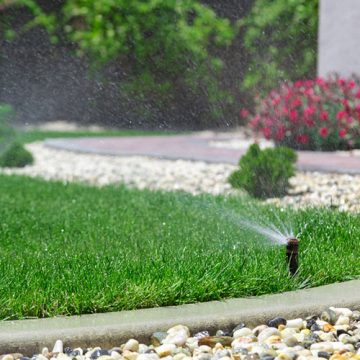When you think about types of irrigation, you might think of sprinklers and… maybe not much else. In reality, there are many different types of irrigation systems used on landscapes ranging from residential backyards to commercial properties. In this article, we’ll review the different types of irrigation as they relate to residential and commercial landscaping.
What are The Different Types of Landscape Irrigation?
Installing an irrigation system helps maintain the beauty of your landscaping, ensuring it’s neither overwatered nor underwatered, and eliminates the guesswork of hand watering. But in order for it to be successful in this regard, it needs to be the proper type of irrigation system for your space. Each different type of landscape irrigation has a specific purpose and certain benefits and drawbacks, as well as environments it’s better suited for.
Sprinkler Irrigation
Sprinkler irrigation is probably the first kind of irrigation system that comes to mind, largely because sprinkler irrigation systems are popular for everything from residential lawns and commercial landscapes all the way up to large farms.
Sprinklers are installed using pipes that flow water to sprinkler heads, which release the water in a controlled spray. Sprinkler heads can come in different sizes and patterns, dispersing water in differing amounts and directions in large or small radii. Sprinklers are popular because they’re easy to operate and effective for lawns of any size or slope and nearly any kind of soil, and they can also be used to distribute pesticide or fertilizer in addition to water. Many of our residential and commercial clients rely on sprinkler system irrigation to keep their lawns lush and maintained with less hassle.
Drip Irrigation
Drip irrigation utilizes pipes with small openings to trickle water slowly and evenly over soil, similarly to subsurface irrigation, only above the surface. Because of their design, these systems are particularly useful for plant beds or gardens, rather than large, grassy lawns. The pipes are placed closely to plants and designed to supply each plant with sufficient water. Drip irrigation systems can be specially designed to better suit the plants’ needs, the soil type, the landscape, the climate and other factors so that they supply the right amount of water at the right frequency. Drip systems can also be used to apply fertilizers, and tend to improve yield and seed germination. They can also help reduce instances of weeds, and they tend to be more environmentally friendly than sprinklers, as less water is lost to evaporation or wind.
Blended Systems
A blended system is exactly what it sounds like: a mixture of two or more types of irrigation systems utilized in a landscape. Irrigation systems aren’t one-size-fits-all, unless you’re dealing with a large, uniform area, which many landscapes aren’t. For a blended system, you might utilize sprinkler systems in some areas of a lawn and drip irrigation in others. A blended system is all about helping you care for every inch of your space in a way that’s practical and easy to maintain.
Which is The Best Type of Irrigation?
Every type of irrigation system has a purpose (and a lawn) it’s best suited for. What type is best is going to depend on your space and your needs, your landscaping, your climate, and a number of other factors. But the good news is you don’t have to figure it out on your own. To find out which of these irrigation systems is best for your space, contact Green Turf today.

